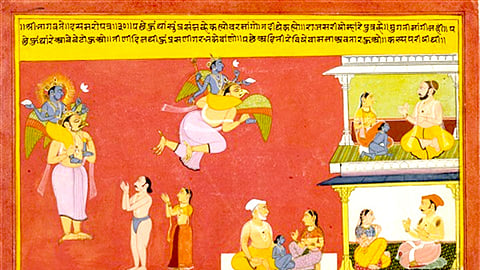- Commentary
- History Vignettes
- Notes on Culture
- Dispatches
- Podcasts
- Indian LanguagesIndian Languages
- Support

THIS SERIES BEGAN WITH THE STORY of Dr. Francis for a reason. He was just the latest in a protracted marquee of European travellers to India who noticed the intrinsic trait of Hindus, described earlier. Another way to characterise this trait is this: although the teeming millions of Hindus that the British encountered were illiterate and starving, they were—in the clouded European view—astonishingly well-informed, had a profound outlook towards life and were highly cultured. The multifaceted scholar Ananda Coomaraswamy described these Hindus memorably: “scratch their skin, give them a bath and clothe them in finery, and they will be fit to rule a wise and just kingdom.”
Regrettably, in their unquenchable hunger for loot, till the very end, the British could never understand the source-fount of Hindu culture.
With the benefit of eons of accumulated wisdom and a wealth of historical material, it is clear that our ancient Rishis, Gurus and Acharyas relied on direct communication of essential knowledge and developed creative and malleable methods for its retention and transmission. Over time, these methods were systematised and through them, this essential knowledge reached even the last person in the Hindu society. This is the profoundest working example of direct benefit transfer: that is, even the “last man on the street” was imbued with sacred knowledge without passing through the rigour of scholastic education.
The Sanskrit term for knowledge is Shruta—that which is heard. Its direct translation in Tamil is befittingly, Kelvi. In Kannada, the word Kelu means “hear or listen.” The titanic scholar Dr. V. Raghavan describes this inimitable and sagely system of Hindu cultural and sacred education with vivid imagery drawn appropriately from agriculture, the first culture:
That our religious history has thrown up saints from among weavers, cobblers, potters, shepherds and Harijans shows how widely the soil has been irrigated and fertilised by the country’s spiritual engineers.
That irrigation first occurred with the tradition of reciting the Ramayana, the Mahabharata and the Puranas, the triad of our sacred literature. In fact, Bhagavan Veda Vyasa himself declares that he composed the Mahabharata to broadcast the distilled essence of the Veda to the world. We must remember that the Ramayana was originally sung, that it is a musical epic.
This sacred triad expounds on the secrets of the Veda by narrating stories of the lineages of august personalities including Rajarshis and Rishis, who through their deeds showed how Dharma must be upheld in the mortal world to attain immortality. Then there are the familiar stories of the grand, delightful, and often bizarre sport of the Devatas and divine incarnations who come down to the earth and crush Adharma as a means of stamping the supremacy of Dharma. We also get a detailed, guided tour of the various celestial worlds complete with the Apsaras, Kamadhenu, Kalpavruksha, etc., but even these worlds come with a warning: that there is an expiry date, we cannot stay there permanently. Even better, these celestial worlds should not be our highest aspiration. The inner world, Atmananda is indeed our highest dwelling. To this delectable and extensive feast of sacred literature is added incidental details of cosmogony, discussions on the nature of Time and substantial details of the sacred geography of Bharatavarsha.
This is a sweeping syllabus of both life and afterlife, a well-rounded and embracive education in the essential core of the eternal Dharma, Darshana and Achara. This essential knowledge automatically includes a range of ancillary knowledge in its ambit such as morals, ethics, values, and history. The ultimate purpose and intrinsic feature of this education was to prepare the human in his quest for ascent to divinity. This education was open to all and given freely because the givers considered it their sacred duty. It was true universal education.
It is because these vital roots have been chopped off that we today have a vast gamut of useless tripe crowned by something called ”personality development” and “leadership.”
BROADLY SPEAKING, THE MOST EFFECTIVE methods of teaching sacred knowledge included recitation, storytelling and performing arts. The refrain of every Guru and Acharya in our tradition remains this: the sublime and regal philosophy of the Veda (Prabhusammita) were transmitted to the common people through the stories of Itihasa and Purana, narrated in the tone and tenor of a friend (Suhrutsammita). In the lovely words of the late Pandita Vajapeyam Srirangachar:
The word of the Veda is akin to the command of an emperor. Our job is to simply obey. There is no scope of questioning the why and how of the command. But the Puranas are wholly unlike this. They unravel to us the same secrets of Dharma as the Veda. However, like a close friend, the Puranas understand our limitations and doubts and questions and discuss them threadbare. They give us the detailed picture of virtue and vice, good and evil through stories and examples of real people. In this manner, they win over our mind and heart and motivate us towards right action. The ultimate aim of both the Veda and the Purana is to elevate us. The difference is only in the method of instruction.
Indeed, the preface of every Itihasa and Purana unfailingly mentions that they were recited by Sūta-paurāṇikas to vast assemblages of people gathered typically at Sattras (incorrectly translated as sacrifice). In fact, this facet of Puranic recitation is another area that shows the Hindu cultural and social continuity. The popular surname Puranik itself indicates this in a living fashion.
To be continued
The Dharma Dispatch is now available on Telegram! For original and insightful narratives on Indian Culture and History, subscribe to us on Telegram.
